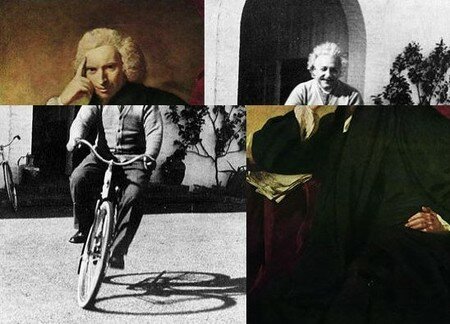Einstein and the atomic viol?
You may already know that Laurence Sterne, the celebrated author of Tristram Shandy and A Sentimental Journey Through France and Italy, was a very keen gambist. Of course, that interests us: he was born in 1713 and died in 1768 - which makes him a perfect contemporary to JC Bach, Abel, and the ineffable Burney.
How does Einstein come into the picture, one might ask?
Well he doesn't. Because it wasn't Albert, unfortunately, but Alfred, a remote cousin, who wrote about the viol in A Short History of Music (1957, New York: Vintage Books). The way he describes the use of a viol resemble very much Sterne's diegetic approach, as you shall see. The passage that follows is extrated from Freedman's Laurence Sterne and the Origins of the Musical Novel, and the extracts he quotes himself are Einstein's (talk about Russian dolls):
Through most of the sixteenth and seventeeth centuries, and, in England, through part of the eighteenth as well, the viola da gamba was the instrument of virtuosity, used extensively for "embroidering a bass with brilliant runs, arpeggios, and other embellishments" and for building up "a polyphonic structure out of its own resources". The viola da gamba lends itself admirably to rich "chords and music in parts, as well as to rapid and brilliant divisions. In the higher register, beyond the frets, it can do all the tricks of expression of the violin, and with as free a tone... Furthermore, a continual variety of effects was devised from varied tunings of which there were many."
There is only so much time one can spend in the BNF without going mad, so I didn't get to copy more of Einstein's delightful comments about the viol. However links between Sterne's writing and his knowledge of viol music (not to mention his own practice of the instrument) are obvious, and I shall attempt to sum them up quickly:
*explosion of the diegesis in separate though connected side narratives = pratice of divisions
*embellishments and complexity of use of language = baroque ornamentation on melodic line
*virtuosity = virtuosity characteristic of the late practice of the viol in the 18th century (see Abel, Lidl)
*extremely polyphonic diegesis (story-telling incumbs to different characters) = polyphony inherent to the instrument (chords, flat bridge)
*(apparent) improvisation in the narration = improvisation was one of Abel's strength on the viol
So, finally, answering the question of my title : No.

/https%3A%2F%2Fprofilepics.canalblog.com%2Fprofilepics%2F3%2F1%2F318171.jpg)



/https%3A%2F%2Fstorage.canalblog.com%2F60%2F70%2F369818%2F25422739_o.jpg)
/https%3A%2F%2Fstorage.canalblog.com%2F89%2F01%2F369818%2F24776514_o.jpg)
/https%3A%2F%2Fassets.over-blog.com%2Ft%2Fcedistic%2Fcamera.png)
/https%3A%2F%2Fstorage.canalblog.com%2F07%2F98%2F369818%2F23323681_o.jpg)